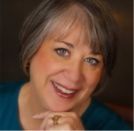|
Business Success Newsletter |
|
|
| |
|
| |
|
|
 Greetings! Greetings!
Welcome to this edition of Business
Success, dedicated to helping
business owners build a better
business...today!
Are you capitalizing on the unmet
needs of a niche market in which
your business could excel? Our lead
article this month features tips on
finding a niche market and making it
work for you.
We are taking a different tack this
month with our article from guest
writer Cynthia Kyriazis., who is
embarking on a series of articles
about how our thinking and our
internal advisors affect our actions
and our success. I encourage you to
tune in for the next few months to
learn more!
Check out our upcoming events! Our
monthly Businesses Getting Results
classes are open to the public as
well as Advisors On Target clients.
As usual, all of our guest writers
bring you valuable tips on to help
you run a more professional
business!.
Read On!
Linnea Blair |
|
Quotable Quotations
"Leadership is an active, living
process. It is rooted in character,
forged by experience, and
communicated by example."
-John Baldoni |
|
|
|
What's Next?
I hope you are taking time for vacation
and relaxation with family and friends
this summer! I find that when I am
away, when I do reflect upon my
business, (face it, all business owners
do, even when we're on vacation!) I look
at it differently. The mind is more
open to new ideas and new strategies.
Jot down those ideas, and take time for
a mini-planning session upon your
return.
It might just make the difference in how
the rest of your year goes!
Give us a call at 619.291.3700 and let
us help you set up an action plan to
reach your goals!
Advisors On Target has options that work
for you:
~ Business Coaching
~ Individual Consulting
~ On Target Group Program
~ Business Performance Review
~ On Target Online
Find out
more! |
|
|
Upcoming Events:
Professionalizing the Family Business -
Businesses Getting Results Teleclass
Presenter: Linnea Blair, Advisors On Target
Thursday, August 14th, 2008 - 1:00 PM
Eastern
(12:00 PM Central, 11:00 AM Mountain,
10:00 AM Pacific)
Family owned businesses make up a major
portion of the economy. On the other hand,
they are volatile and account for the large
majority of business failures. Sadly, the
figures for successful transitioning between
generations are not optimistic. Only 30% of
family businesses make it to the second
generation, 12% to the third, and 3% to the
fourth.
What are the reasons for failure? Can they
be minimized? The answer is 'Yes!'
This BGR Teleclass explores these topics and
offers a number of ways in which family
owned businesses could become more
professional in their approach to business
to promote
their likelihood of survival.
Registration cost: $39.00 OR
Subscribe for 12 Months* for only $359, a
savings of $109!
For more
info. or to register for Tele-classes, click
here |
Finding Your Niche

Large companies often leave smaller market
segments unserviced since they don't
represent, for them, a sufficiently
profitable target. A small business can
capitalize on these unmet needs by
developing a product or service that fills
the gap. You can think of a niche market as
a narrowly defined group of potential
customers.
A niche market can be a built on developing
a product for a particular consumer
demographic, such as manufacturing kosher
milk products to meet the dietary
requirements of particular religious groups.
Many service firms have grown their business
by deciding to build up expertise in how a
certain industry works and focusing on
attracting clients from that industry based
on the expertise they can offer. Others will
concentrate on a particular service line
such as a dentist who specializes in
pediatric work. Still other businesses
concentrate their resources on marketing to
a particular region, so they could be said
to operate in a geographic niche. The
competitive advantage of being in a niche
market derives from being alone there and of
being able to offer a level of expertise
others can't match or perfectly filling a
particular need.
Niche market businesses are frequently small
scale since they tend to focus on
identifiable sub segments of a larger market
such as cleaning blinds instead of cleaning
offices in general. But it's an error to
think that that is a necessary association.
The First Commerce Bank, in Charlotte, N.C
became hugely profitable concentrating on
servicing small business clients and some
accounting firms have moved into the big
league through providing advice to clients
in specific industries or occupations.
There are three basic ground rules for
making niche
marketing work for you.
1. Develop a detailed marketing plan:a
well developed marketing plan is the key to
successful niche marketing. It has to be
very specific about the basic business
concept - what you are selling, who you are
selling it to, why they would buy it (the
benefit to the customer) and how you will
make money out of it.
2. Appoint a niche champion:the
secret to tapping into a niche market and
working it to get the best return is to know
just what it is the consumer will really
value from the product or service you are
offering. If you need to, find a niche
champion with the knowledge and experience
in the product/service that will enable you
to develop just the right package. If your
niche marketing initiative is really a
subsidiary line of business within a larger
organization, for instance preparing a line
of gluten-free products within a general
bakery business, ensure the project is
properly funded and the niche champion has
sufficient authority and respect to be able
to keep the project on track. Don't throw
away the opportunity through bad planning
and execution.
3. Market hard:
niche marketing succeeds or fails on its
success in connecting with exactly the right
kind of customer. Both the target market and
the marketing channels that will most likely
reach them should be closely defined. Give
careful consideration to what marketing
messages will work best as 'hot buttons' for
prospects and will prompt them to purchase
the product. Marketing spend may not need to
be large but it does need to be well focused
so as to get your name known within the
target market and educate them to the
benefits of using your product/service. In
the case of gluten-free bakery products, you
could advertise in health food stores, food
bars, natural healing centers and healthy
living publications.
The famous entertainer Bill Cosby once said,
"I don't know what the secret of success is,
but I know the secret of failure and that
was trying to please everybody." The same
wisdom applies in business as in
entertainment. For many businesses, large
and small, creating a product or offering a
service that satisfies the needs of a niche
market has been a recipe for success.
Information for this article is sourced from
RAN ONE. |
|
Introducing Your Advisors
by Cynthia Kyriazis
Consider
this. Each of us has somewhere between
12,000 to 50,000 thoughts a day. More than
you thought, huh? Some of them help you get
what you want and some get in the way of
what you want or what you are shooting for.
And these results all began with just one
thought.
If you attended the Advisors On Target June
26 webinar, you know that I talked about the
results of a study I did assessing how
successful painting contractors think. What
makes them different? How are they so
successful? I used the 6 AdvisorsÔ
assessment program as the tool for my
findings.
6 Advisors is an online assessment program
that measures the type of advice you give
yourself and the degree of this advice. We
each give ourselves advice in 6 different
yet distinct arenas. These 6 categories
include thoughts relating to:
1. Others
2. Yourself
3. Getting things done
4. The way in which you spend your time
5. Ideas, concepts and discipline
6. Turning dreams into reality and
motivation
Your thoughts impact the money you make, the
debt you may have, the passion you may or
may not have, your energy level, your stress
level, your relationships, and your self
esteem to name a few.
We all give ourselves plenty of balanced
advice and this has helped shape many of our
outcomes over the years. But advice we give
ourselves that is unbalanced usually ends up
resulting in outcomes that may be filled
with minefields. The objective is to try and
recognize when advisors are out of balance
and shift course to achieve better results.
But this advice and internal dialog we all
have has probably been around for a long
time, so shifting thoughts and making a
change will take some focus and diligence.
But change is good! It can mean improving
your ability to manage your emotions,
choices and actions so you end up with
better results and a richer life.
Join me for my next article on the
Empathy-Intuition advisor which focuses on
the advice we give ourselves about others.
copyright 2008 Cynthia Kyriazis and Six
Advisors, Inc.
Cynthia Kyriazis is a Productivity expert
who helps business owners and their teams
gain consistency with paper, time and
decision making management. She can be
reached at cynthia@propartnersinc.com
or 913.649.0878 |
|
 Make
Bank Reconcilations Easier Using the "Undo
Last Reconciliation" Feature Make
Bank Reconcilations Easier Using the "Undo
Last Reconciliation" Feature
By Teri Milligan, QuickBooks Consulting and
Implementation
Last month I focused on the "Locate
Discrepancies" button that is part of the
Bank Reconciliation feature in QuickBooksTM. Like
the "Locate Discrepancies" button, another
overlooked, but very helpful part of the
Bank Reconciliation feature in QuickBooksTM is the
"Undo Last Reconciliation" button. This
button is located right next to the "Locate
Discrepancies" button that you see when you
are entering your bank statement
information. It's in the first screen, at
the bottom, after clicking on "Bank
Reconciliation" from the Home Page or from
the Banking Menu.
Intuit recommends backing up your data
before undoing a previous reconciliation,
which is always a wise choice.
The "Locate Discrepancies" button and the
"Undo Last Reconciliation" button are often
used in conjunction with each other. If
you've had to turn to the "Locate
Discrepancies" button, but are unable to
rectify the issues with your bank
reconciliation using that report, it is
sometimes wiser to undo your last bank
reconciliations until you reach one that is
correct and then re-reconcile your bank
statement or statements. This can often be
more accurate and less time consuming.
When you click on the "Undo Last
Reconciliation" button, QuickBooksTM will
tell you exactly what to expect by
continuing with this process. Please read
this screen. The important item to know
about this process is that QuickBooksTM will
not remove any of your transactions and all
service charges, interest and other
adjustments made to your bank account, as
part of your prior reconciliation, will
remain in your bank account.
The "Undo Last Reconciliation" button is
really meant as a means to correct a bank
reconciliation(s) that has (have) gotten off
course. Just remember to use it wisely and
after careful consideration.
To learn more about how you can use
QuickBooksTM more efficiently in your
business you can contact Teri at
619-463-6851 x2 or by e-mail at
teri@terimilligan.com. |
|
Employee Expenses
The IRS Increases Mileage Rates

Due to Gas Prices
By Christopher W. Olmsted, Attorney
On June 23rd the Internal Revenue Service
announced an increase in the standard
mileage rates for the final six months of
2008.
The rate will increase to 58.5 cents a mile
for all business miles driven from July 1,
2008, through Dec. 31, 2008. This is an
increase of eight (8) cents from the 50.5
cent rate in effect for the first six months
of 2008.
The IRS announced the unusual mid-year
increase in recognition of recent gasoline
price increases. The IRS normally updates
the mileage rates once a year in the fall
for the next calendar year.
"Rising gas prices are having a major impact
on individual Americans. Given the increase
in prices, the IRS is adjusting the standard
mileage rates to better reflect the real
cost of operating an automobile," said IRS
Commissioner Doug Shulman. "We want the
reimbursement rate to be fair to taxpayers."
While gasoline is a significant factor in
the mileage figure, other items enter into
the calculation of mileage rates, such as
depreciation and insurance and other fixed
and variable costs.
The optional business standard mileage rate
is used to compute the deductible costs of
operating an automobile for business use in
lieu of tracking actual costs. This rate is
also used as a benchmark by the federal
government and many businesses to reimburse
their employees for mileage.
To view the IRS announcement:
Click Here
Employers should consider increasing the
reimbursement rates to match the new IRS
rate. Generally, employers must reimburse
employees for travel expenses incurred in
the course of work. For example, in
California, Labor Code section 2802,
subdivision (a), requires an employer to
indemnify its employees for expenses they
necessarily incur in the discharge of their
duties. Note that in California, paying the
IRS rate does not guarantee that the
employer has fully reimbursed the employee
for actual travel expenses. The California
Supreme Court recently addressed employee
travel expense reimbursement in a case
titled Gattuso v. Harte-Hanks Shopper, Inc.
Questions? Please call Chris Olmstead.
Mr. Olmsted is an attorney with Barker
Olmsted and Barnier, LLC, in San Diego. For
more information about labor and employment
law issues, you may reach him at (619)
682-4040 or by
email at
cwo@barkerolmsted.com or you may visit
www.barkerolmsted.com.
The article presented herein is intended as
a brief overview of the law and is not
intended to substitute as legal advice. Any
questions or concerns regarding any statute
or case law should be addressed to a
licensed attorney. |
|
Linnea
Blair
Advisors On Target, LLC
(619) 291-3700
www.AdvisorsOnTarget.com
ljblair@advisorsontarget.com |
|
|
|
![]()